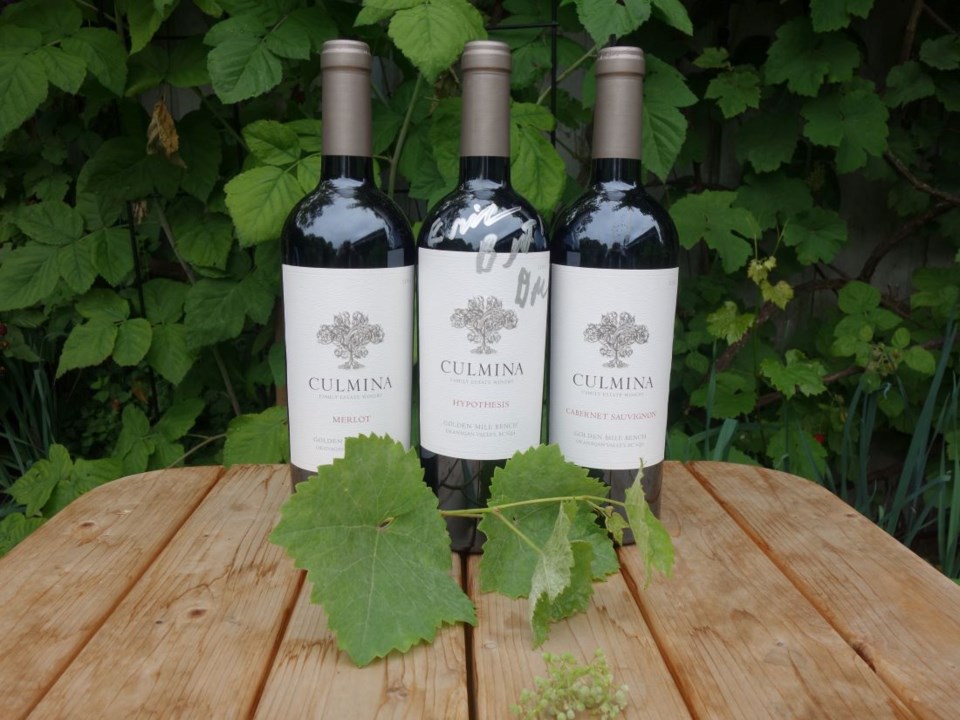Culmina Family Estate Winery’s Don Triggs’ latest mission is to test the potential of the Okanagan in making premium Bordeaux style reds. Formerly a leading partner in Jackson Triggs, Canada’s largest winery, Triggs is now planting roots along the Golden Mile Bench near Oliver.
Culmina’s red grapes are planted on the 10 acre Arise Bench which shares many of the characteristics of Bordeaux France, including the highest heat unit’s benches on the estate, a prerequisite for ripening reds.
A rising star in the Okanagan is Cabernet Franc. The 2014 Culmina Cab Franc ($38) spends 16 months in French oak and is aged three years in the bottle. As Triggs proudly states, “We build wines that give a lot of structure. We’re designing wine to go with food and can age. We don’t want wines that will be at their best in six months.”
Triggs describes it as “classic Cab Franc” possessing an “earthy character”, but there’s also a good balance of red currant, sage, cedar and cloves.” Cabernet Franc might be described as the feminine side of its more popular sibling, Cabernet Sauvignon. In its youth it is more fragrant, smoother, and more charming than the tougher and more muscular Cab Sauv.
Triggs adds, “We have some demand for it as a single varietal but a lot of it is used in the blend (Hypothesis). Properly stored it will last 15 to 20 years.” Enjoy with a pork chop and salsa verde.
Next we turn to the most famous grape variety on Earth, Cabernet Sauvignon. Culmina’s 2015 Cabernet Sauvignon ($39) is aged in 25-per-cent new oak and the rest in one-year-old casks.
Expect an elegant and dense red with a cherry, blackberry, and vanilla bouquet, flavours of cassis, tobacco, and ripe fruitcake, and a really long finish. Match with blackberry glazed duck or steak tartare.
The 2014 Culmina Merlot ($35) is bigger, fatter, and has a longer finish than the Cab Sauv. Here in B.C., Merlot ripens earlier than Cabernet and has been more successful. Merlot has thinner skins than Cabernet Sauvignon, therefore, the wine is less tannic and doesn’t require as much aging to smooth out the tannins. It is often described as “very approachable” and “restaurant ready”.
This Merlot’s nose displays a plummy character along with dark ripe fruits and a whisper of violets. It is rich, smooth and round with black cherry and chocolate flavours. Serve with grilled rosemary and balsamic flat iron steak with porcini mushrooms.
Saving the best for last, the 2013 Culmina Hypothesis ($46) is a Bordeaux style blend of 45-per-cent Cabernet Sauviginon, 33-per-cent Merlot, and 22-per-cent Cabernet Franc. The Cab Sauv adds texture and tannins for aging potential, the Merlot and Cab Franc contribute softness, and they all add their own unique aromas and flavours for complexity.
When asked why he named it Hypothesis, Triggs replied, “Hypothesis means proposal or proposition. To use it was a fitting way to describe our top wine. We would never say that our wine was perfect or the best but rather the best we were able to do that year.”
Triggs added, “Said simply, our 2014 Hypothesis was our very best effort for 2014 including the best blocks, the choice and proportion of each variety, harvest dates, the best coopers and the optimum selection of new versus older barrels, aging time in barrel, aging time in bottle, etc.”
Enjoy the Hypothesis with a rack of lamb and a jus made with a splash of Hypothesis. Although it can be enjoyed now with a meal, it will evolve and reveal its full potential if aged for a decade.
Eric Hanson is a Richmond wine educator and journalist



